Asante Traditional Wedding.
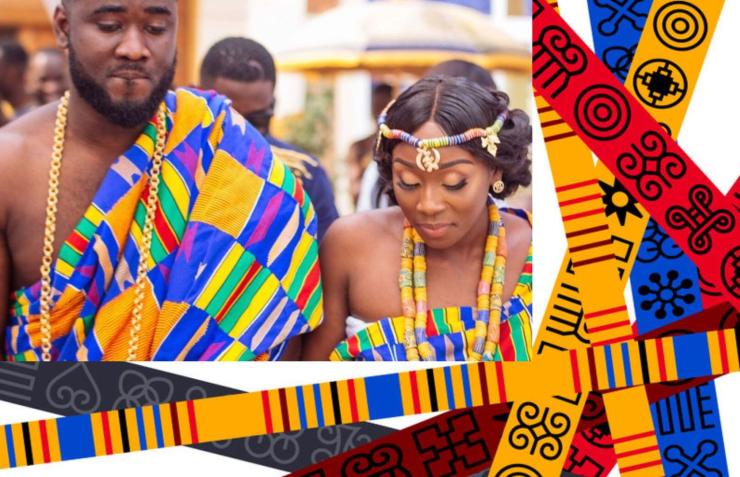
The Asantes, have a unique style of marriage ceremony. It is an important community engagement as it involves the couple,
the couple’s immediate and extended families, and
the community at large.
Each ethnic group in Ghana has its unique way of performing a marriage ceremony. However, for every group, there are similar processes involved. For instance, the Akans, Ga-Adangmes and the Ewes from Southern Ghana all accept money and special drinks for the first step of the marriage process known as ‘kookooko’ (knocking).
It is unique to Asante wedding traditions and a symbol of respect in unifying the two families.
Weddings in contemporary society come with themes to capture a certain elegance and inspire uniqueness. Aside from the bride and groom’s dresses as well as that of their parties, the Kente cloth dominates.
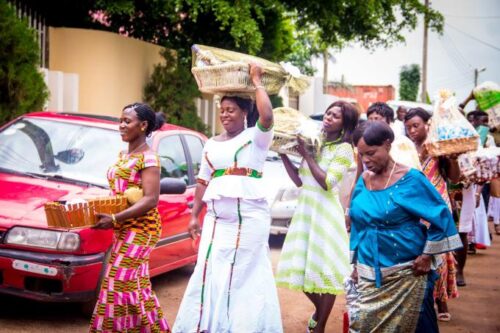
The Groom’s family presents the items requested by the bride’s family. CC BY 4.0/ Quami43
Traditionally, when an Asante man wants to marry, he is first expected to seek the approval of the woman he wants to marry, through a secret meeting called Kasasie (Courtship). If the woman agrees, the man then informs the members of his family who then begin investigations into the woman’s family background. If the man’s family is satisfied with their investigations, the man (groom) and his family members formally ask the bride’s family for the bride’s hand in marriage which is called ‘kookooko’ ceremony.
This ‘knocking’ ceremony is done to inform the lady’s family, officially, of the man’s intention to marry her. The head of the delegation would use flowery language to refer to their mission. “Our noble son here says he has seen a very beautiful flower in your garden, and he would like to ask permission to pluck this flower”. This is a clear indication that the groom is willing to do what is traditionally right by asking for the bride’s hand in marriage from her family. The ‘knocking’ ceremony again serves as a chance for both families to be introduced to each other.
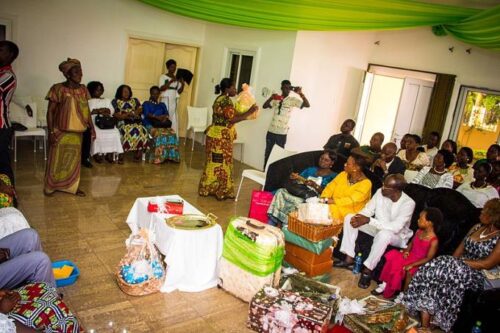
The bride’s family is accepting the items requested from the family CC BY 4.0/ Quami43
The man’s family would take along ‘tri nsa’ (head drinks). This could be two or three bottles of Schnapps, palm wine, or cash. The man’s family then first knocks at the entrance of the home, then at the door. The bride’s male family members take their time to open the door. When they finally do so, the groom and his family present them with gifts of money, alcoholic beverages, and other special gifts for the bride.
Libation as a form of prayer
Libations are important in Asante wedding traditions, as they are used to consecrate the union. The alcoholic drink presented is used to pour libation as a traditional form of prayer to the ancestral spirits and God. The marriage process has begun. Food and drinks are made available for the groom’s family present at the knocking ceremony.
The groom’s family then demands a list of items for the traditional wedding proper which is set for another date. Akan include an Asante traditional marriage list of items (dowry/bride price) and include head drink, usually whiskey or wine, a new suitcase containing shoes, lady wears, headpieces, and other necessities the bride would need, a bottle of whiskey and money for the father of the bride, a pair of sandals and money for the mother of the bride.
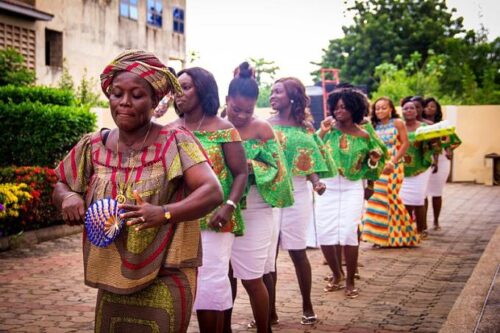
A procession presenting the bride to the groom and his family. CC BY 4.0/ Quami43
Others are at least six pieces of African wax print clothes for the bride, a stool for the bride, money for the bride to start a business, an engagement ring, an engagement Bible, and money for the bride’s brothers (akonta sikan) as a thank you gift for protecting their sister (bride). If the bride doesn’t have brothers, it goes to her male cousins, with cooking utensils, and jewellery for the bride.
As preparations for the traditional marriage start, the bride’s family does background checks on the groom and his family. Enquiries are made whether the groom is from a good family? Is there any history of strange or life-threatening illnesses in the family? Is there any record of criminal behaviour on the part of the groom? Is the groom being truthful about his marital status? When positive answers are given for these enquiries, the marriage preparations proceed smoothly. A date is then fixed for the traditional wedding.
Usually, the traditional marriage takes place at the bride’s home. Where that is not suitable, any other nice venue is chosen. Even before the ceremony kicks off, music and dance fill the atmosphere, be it music from traditional ‘adowa’ dance groups or a live band, or music from a disc jockey that makes the atmosphere filled with good cheer and joy.
Dressed like royals
The bride wears her best dress adorned with gold ornaments. During the traditional marriage ceremony, the rich culture of the Asantes is displayed by the bride and groom who are dressed like royals in brightly coloured Kente and adorned with gold jewellery and regalia. This is to give the whole occasion a good and beautiful traditional look.
On the day of the traditional wedding ceremony, once the groom’s intentions are announced, both families sit on opposite sides of the room or under a canopy if it is an outdoor event.
Elders from both sides begin the ceremony with prayers and introductions. The bride is usually not in the room or the venue for the ceremony. The groom does not speak.
A spokesman from the groom’s delegation who are usually known as the ‘masters of ceremonies’ (MCs) announces their intention, saying that the groom has seen a beautiful flower in the grounds of the house and would like to uproot it. The use of ‘flower’ is usually used as a metaphor for the bride to express her purity and virginity.
The dowry is then presented in a procession from outside led by the groom’s representative as the MC. The dowry is carried by family members and friends of the groom accompanied by a chosen traditional song. The dowry carriers dance in a procession with the items either on their heads or hands.
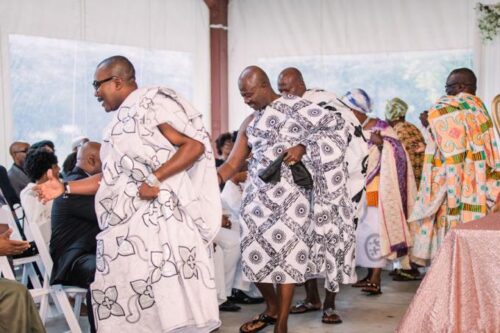
Family of the groom greeting bride’s family on their arrival at the wedding. Photo DDDA
In a traditional way, the bride’s family, also represented by an MC, decides whether the dowry is plentiful, or not based on the marriage list given to them on the day of the knocking. After both sides reach an agreement, a few decoys are brought in to confuse the groom. The bride is also escorted in a procession led by her friends or family members, mostly her sisters or female cousins who are also traditionally dressed.
Amidst music and dancing, beautifully clad in rich Kente and adorned with beads, the bride is literally paraded for all to see and admire her beauty. Mostly, the groom and bride wear matching outfits. She goes around to shake hands with the groom’s family as a sign of welcoming them. She is then introduced to the groom’s family with a lot of accolades showered on her: “our pretty queen”, “our lovely lady”, “our well-groomed woman”, “the apple of our eye” and many others.
After that, she is asked three times by her father if she agrees to marry the groom, and whether they should accept the dowry and gifts, or not. Once she agrees with a loud yes, the bride is then presented to the abusuapanyin (head of family) of the groom’s family, asking that she is kept as good-looking as she has been on the day of the marriage ceremony. The bride moves to sit with her groom.
The groom wears a ring on the bride’s finger and a bible is presented to the couple as a symbol of the importance of religion in their marriage. Prayers are said, blessings given, and congratulations and pieces of advice are also given to the couple by selected elders. They focus on areas like household responsibilities, sex, finances, and communication; some are indeed humorous and some serious. The traditional marriage is customarily a complete marriage process on its own and the couple are declared husband and wife in the eyes of the community.
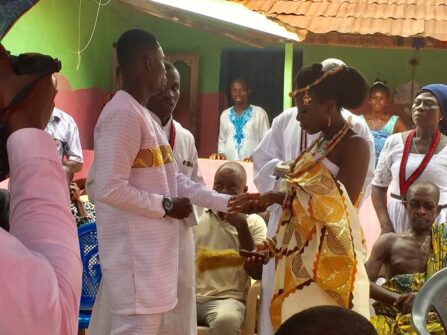
Wearing of the ring at the wedding. Photo DDDA
It is now a fun time where assorted dishes and drinks are served, including jollof rice. In addition, locally made Ghanaian foods like Fufu, Ampesi, Etor, Apeprensan are usually on the menu. Customised traditional wedding souvenirs (chocolates, pens, mugs, hand towels, bowls, and flasks) are distributed first to the groom’s family and audience.The bride and groom now have the opportunity to go around to greet their guests and thank them for being a part of their day of traditional marriage. Before the bride leaves her home or parents, drinks are poured out (libation) as a sign of respect. Her brothers may demand ‘akonta gye sika’, a protection fee to be paid before she leaves her parents’ home. After the groom pays this fee, he sends some delegates to escort the bride to his home. (D.D. D. A.)



